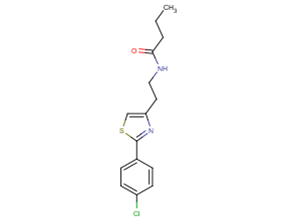
Azoramide
CAS No. 932986-18-0
Azoramide( Azoramide )
Catalog No. M19268 CAS No. 932986-18-0
Azoramide, a small-molecule modulator, has the antidiabetic activity of unfolded protein response.
Purity : >98% (HPLC)
 COA
COA
 Datasheet
Datasheet
 HNMR
HNMR
 HPLC
HPLC
 MSDS
MSDS
 Handing Instructions
Handing Instructions
| Size | Price / USD | Stock | Quantity |
| 5MG | 39 | In Stock |


|
| 10MG | 47 | In Stock |


|
| 25MG | 91 | In Stock |


|
| 50MG | 142 | In Stock |


|
| 100MG | 259 | In Stock |


|
| 500MG | 624 | In Stock |


|
| 1G | Get Quote | In Stock |


|
Biological Information
-
Product NameAzoramide
-
NoteResearch use only, not for human use.
-
Brief DescriptionAzoramide, a small-molecule modulator, has the antidiabetic activity of unfolded protein response.
-
DescriptionAzoramide is a small-molecule modulator of the unfolded protein response with antidiabetic activity. Azoramide mproves ER protein-folding ability and activates ER chaperone capacity to protect cells against ER stress in multiple systems. Azoramide also exhibited potent antidiabetic efficacy in two independent mouse models of obesity by improving insulin sensitivity and pancreatic β cell function. Azoramide can be potential drug candidate for type 2 diabetes.
-
In VitroAzoramide (0.01-100 μM; 0-24 h; Huh7 cells) regulates ER folding and secretion capacity without inducing ER stress.Azoramide (15 μM; 2-16 h; Huh7 cells) protects cells from induced ER stress. Azoramide counteracts Tunicamycin (Tm, HY-A0098)-induced ATF6LD-Cluc secretion and Tm-induced decrease of ASGR-Cluc secretion. Azoramide suppresses Tm-induced GRP78 and CHOP protein expression.Azoramide (15 μM; 2-16 h; Hepa 1-6 cells) alters ER calcium homeostasis and retains a greater fraction of Ca2+ in the ER.Azoramide (0-10 μM; 5 d) attenuates loss of PLA2G6D331Y/D331Y iPSC-derived midbrain DA neurons.Azoramide (10 μM; 5 d) reduces the increase in ROS and ameliorates the decline in mitochondrial membrane potential in PLA2G6D331Y/D331Y midbrain DA neurons.Azoramide (10 μM; 0-30 d) suppresses mitochondrial fragmentation in PLA2G6D331Y/D331Y midbrain DA neurons. Cell Viability Assay Cell Line:DA neurons Concentration:0, 0.1, 0.3, 1, 3, and 10 μM Incubation Time:5 days Result:Enhanced cell viability with 27 and 39% for 3 and 10?μM, respectively.Western Blot Analysis Cell Line:DA neurons Concentration:10?μM Incubation Time:24 hours Result:Decreased the cleaved level of caspase 3 and the ratio of Bax/Bcl2 in PLA2G6 mutant neurons.Enhanced expression of CREB in PLA2G6 mutant neurons.Western Blot Analysis Cell Line:DA neurons Concentration:10?μMIncubation Time:30 days Result:Suppressed increased expression of UPR proteins, elevated the decreased expression level of mfn1, and inhibited the elevated expression levels of DRP1 and Fis1 in PLA2G6 mutant neurons
-
In VivoAzoramide (150 mg/kg; p.o.; daily, for 7 d; Huh7 cells; ob/ob mice) improves glucose homeostasis in mice with genetic obesity and preserves beta cell function and survival during metabolic ER stress. Animal Model:Male ob/ob mice (9-12 weeks of age)Dosage:150 mg/kg Administration:Oral administration; daily, for 7 days Result:Reduces ER stress and improves metabolism in ob/ob mice.Increased the levels of Pdx1 mRNA and improved beta cell function.
-
SynonymsAzoramide
-
PathwayOthers
-
TargetOther Targets
-
RecptorOthers
-
Research AreaEndocrinology
-
Indication——
Chemical Information
-
CAS Number932986-18-0
-
Formula Weight308.82
-
Molecular FormulaC15H17ClN2OS
-
Purity>98% (HPLC)
-
SolubilityDMSO : ≥ 30 mg/mL; 97.14 mM
-
SMILESCCCC(=O)NCCc1csc(n1)-c1ccc(Cl)cc1
-
Chemical NameN-[2-[2-(4-chlorophenyl)-4-thiazolyl]ethyl]-butanamide
Shipping & Storage Information
-
Storage(-20℃)
-
ShippingWith Ice Pack
-
Stability≥ 2 years
Reference
1.Fu S, et al. Sci Transl Med. 2015 Jun 17;7(292):292ra98. doi: 10.1126/scitranslmed.aaa9134. Phenotypic assays identify azoramide as a small-molecule modulator of the unfolded protein response with antidiabetic activity.
molnova catalog



related products
-
Pep 2-8
Proprotein convertase subtilisin/kexin type 9 (PCSK9) inhibitor. Potent inhibitor of PCSK9 binding to LDL receptor (IC50 = 0.8 μM). Restores LDL uptake in HepG2 cells treated with PCSK9.
-
6-NBDG
6-NBDG, a fluorescent glucose analogue, can be used as a fluorescent probe.6-NBDG can be used for monitoring glucose transport and uptake. 6-NBDG can be used as for detecting macrophage-rich atherosclerotic plaques.
-
Glucagon - Like Pept...
Glucagon - Like Peptide 1 (7 - 37)



 Cart
Cart
 sales@molnova.com
sales@molnova.com


